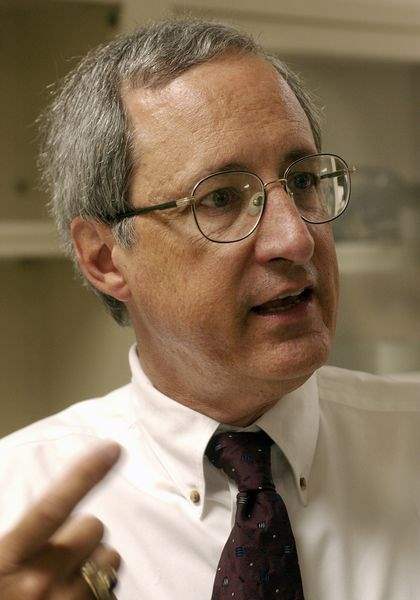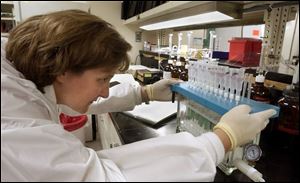
MCO offers crucial tool to police
9/16/2002
Forney: He is MCO's director of toxicology.
blade

Medical technologist Mary Lavoy works in the Medical College of Ohio Hospitals lab, which has a steel cage surrounding it to prevent illegal entry.
Rape is a terrifying experience, but Melodie Brooks, an emergency room nurse at Medical College of Ohio Hospitals, said the stories she has heard from some rape victims are even more unsettling.
“A girl will come in and say ‘I don't remember what happened. I went someplace, I got a drink, and then woke up in a strange place and I'm not sure what's going on',” Ms. Brooks said. “I think sexual assault is horrible to go through, but to lose your memory and be sexually assaulted is even worse.”
What often has happened is the drinks of victims have been spiked with a “date rape” drug. The term refers to a group of drugs sometimes used by rapists to spike drinks of unsuspecting women. The drugs can knock them unconscious and black out their memory.
Some date rape drugs include Ecstasy, GHB (gamma-hydroxybutyrate), and Rohypnol (a brand name for flunitrazepam, known on the street by such names as “Roofie”). These drugs are also referred to as “club drugs” and are also taken illegally by some users for recreational “highs” from their hypnotic effects.
Law enforcement and hospital workers are getting better at recognizing the rape drug problem, but such situations present a unique challenge to those trying to prove a criminal case against an assailant. Unlike marijuana and other drugs, traces of which can remain in the body for weeks, traces of date rape drugs can disappear within four to 12 hours. That's why testing for suspected rape drug involvement has to occur as soon as possible after the incident.
MCO's lab is one of only four in Ohio that routinely performs tests for rape drugs. The lab has everything a modern hospital lab has: beakers, microscopes, and workers in white coats.
But the steel cage surrounding the lab, which extends 10 feet into the ceiling to prevent unlawful entry, does seem a little out of place.
“The whole point is so that no one else can go in and alter or switch samples,” said Dr. Robert Forney, director of toxicology at MCO.
The emphasis on security is important, because unlike most hospital labs, one of the MCO lab's jobs is to test samples used in criminal cases, including rape drug samples. Lab workers must ensure that the “chain of evidence” remains secure.
The testing for rape/club drugs is one of the fastest-growing segments of business for the lab, with hospitals and law enforcement being the biggest clients. MCO conducts tests on about 65 samples monthly, about double what it was seeing when it started testing for the drugs three years ago.
Tim Aukerman, toxicology supervisor at the lab, said most of the testing isn't for true date rape drug situations.
“The majority of what we're seeing is recreational, not date rape [situations],” he said.

Forney: He is MCO's director of toxicology.
Common situations where the MCO lab is used to test for the drugs include police stopping a motorist for driving erratically. A Breathalyzer test may indicate there's no alcohol present, which is often a red flag that other drugs, including date rape drugs, could be the culprit, Dr. Forney said. Other examples include those in which patients show up comatose in hospital emergency rooms and doctors are stumped because routine drug screenings don't detect anything abnormal.
True date rape drug situations are becoming more common, although it may be because nurses, doctors, and police are on the alert for it and more likely to test.
“We've seen far more within the last 12 months than in the two previous years,” said Sally Royston, who works at the YWCA Rape Crisis Center and trains nurses in the Toledo area on how to care for rape victims.
Ms. Royston said she does not have actual numbers for the cases involving suspected date rape situations. However, she said the MCO lab is “well known” by nurses in the state who turn to specialized labs to prove date rape drug cases.
The biggest problem, she said, is that more education needs to be done so both victims and authorities consider testing for the drugs as soon as possible because of the time factor in detecting the drugs' presence.
“People frequently don't come to the hospital until 24 or 48 hours later,” she said, which is almost always much too late to get a positive sample.
Sgt. George Kral, who investigates sexual assaults for the Toledo Police Department, agreed that getting a good sample is difficult.
“A lot of times, by the time we get our reports, [the drugs] are out of the system by the time we suspect them,” he said.
He added that rape drug cases are so new to most officers that they don't consider it.
“But the more we learn about it and understand it, the more we'll use it.”